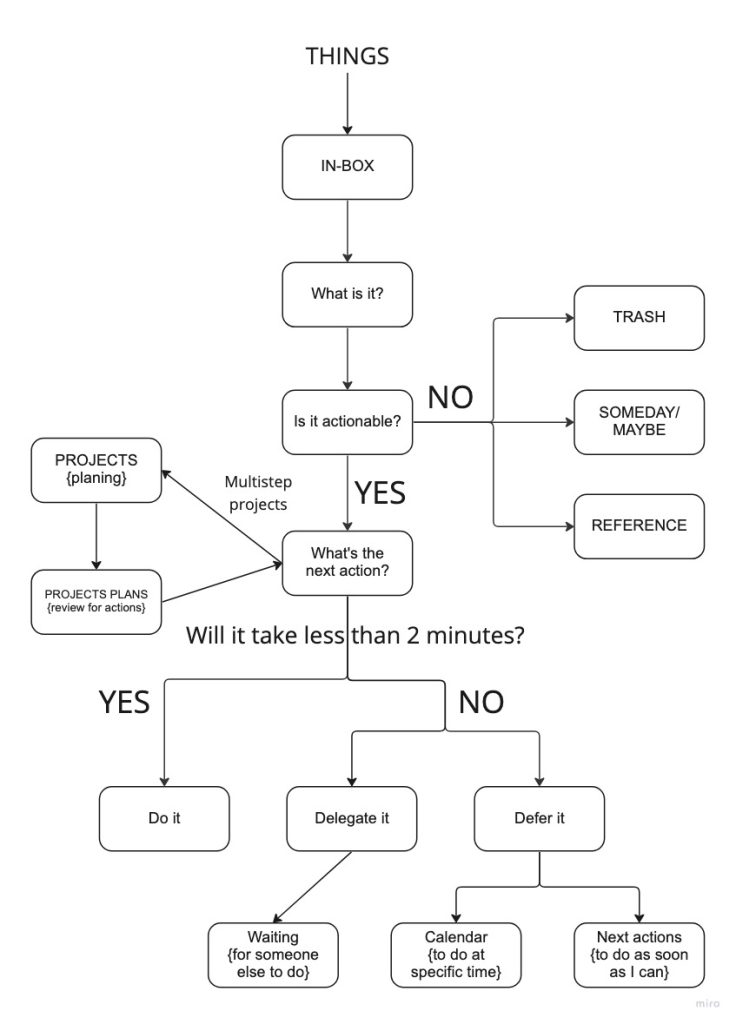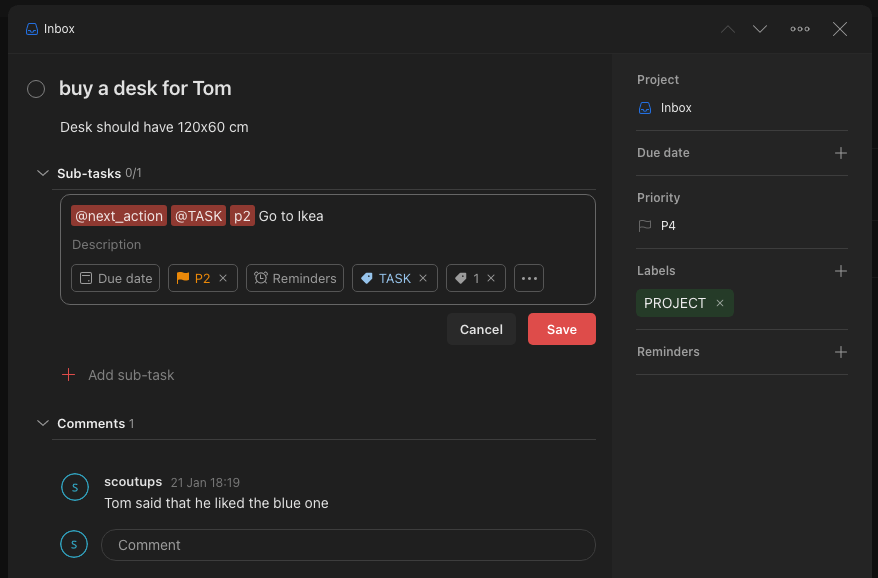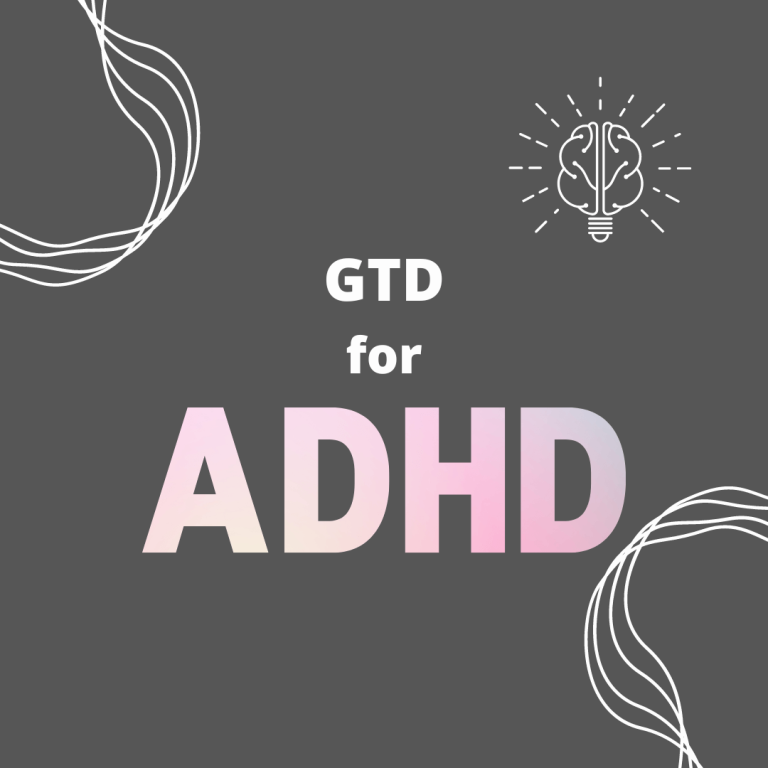Millions of people worldwide suffer from Attention Deficit Hyperactivity Condition (ADHD), a neurodevelopmental disorder where time management and organization can be a struggle. However, the Getting Things Done (GTD) methodology provides a solution to help people with ADHD become more productive and reduce their stress levels. This article will delve into how GTD for ADHD can be applied effectively, the benefits of doing so, and provide practical advice for those just starting out with GTD for ADHD.
The Getting Things Done (GTD) method
Getting Things Done, or GTD, is a time management and productivity method developed by David Allen. The method is based on the idea that a person’s mind is for having ideas, not holding onto them. The GTD methodology allows you to organize all of the tasks, projects, and ideas circling around in your thoughts into a reliable framework. This technique prevents you from becoming overburdened by all of the things you need to do and enables you to concentrate on what is most crucial.
The GTD method consists of five basic steps
- Collect: Gather all of the tasks, projects, and ideas that are on your mind.
- Process: Decide what action needs to be taken for each item, and either do it or put it in the appropriate place.
- Organize: Put the items into the appropriate lists or folders.
- Review: Regularly review your lists and projects to ensure that nothing falls through the cracks.
- Do: Take action on the items on your list, one at a time.

One of the key components of GTD is the idea of “next actions“, which are the next physical, visible steps that need to be taken in order to move a project forward. Focusing on the next actions makes it easy to start and progress on projects, instead of getting bogged down in the details.
GTD has been widely recognized as a powerful and effective method for managing tasks, increasing productivity, and reducing stress. It has been used by individuals, businesses, and organizations of all sizes to increase efficiency and achieve goals.
Main problems of people with Attention Deficit Hyperactivity Disorder (ADHD)
Attention Deficit Hyperactivity Disorder (ADHD) is a neurodevelopmental disorder that affects both children and adults. It is characterized by symptoms of inattention, hyperactivity, and impulsivity.
Symptoms of inattention include difficulty paying attention to details, difficulty sustaining attention, forgetfulness, and being easily distracted. Symptoms of hyperactivity include fidgeting, excessively active, and difficulty sitting still. Symptoms of impulsivity include acting without thinking, interrupting others, and having difficulty waiting for one’s turn.
People with ADHD frequently struggle with organization and time management, which can result in procrastination, missed deadlines, and a sense of overload. They might also struggle with self-control, which can result in impulsivity and bad judgment. They might also struggle with memory and concentration, which makes it challenging to concentrate on and remember crucial information.
Benefit of ADHD
People with ADHD also have many advantages that should not be forgotten! Some of them will be described here, which will have the greatest contribution to doing things. They will be the pillar of strength during the implementation system GTD for ADHD.
Creativity
This is perhaps the most distinguishing characteristic of people with ADHD. A person affected by this disorder can give a different outlook on life, and approach to tasks and situations. Often adults with ADHD are extremely creative, with an artistic soul, and able to invent new ideas and technologies.
Research shows a link between ADHD and divergent thinking tasks – that is, the ability to generate multiple solutions to a problem.
This is because inattention, which is more common in those affected by the disorder, largely leads to thought wandering, i.e., thoughts drifting away from a particular activity or environment. Such drifting can be a source of new, useful, and creative ideas.
Hyperfocus
Although it may seem contradictory, people with ADHD have the ability to focus intensely, known as hyperfocus. This is the experience of deep and intense concentration in some people with ADHD. Properly channeling attention and energy into one’s work, allows one to complete tasks more efficiently.
ADHD is not so much an attention deficit, but rather a problem with regulating the focus of attention on given tasks. Thus, while mundane tasks may involve impaired focus, others can be completely absorbing. According to the researchers, many famous scientists, writers, and artists have ADHD. Their galloping careers came out of nowhere because thanks to ADHD they were able to focus on what they were doing for hours on end.
Lots of energy
Among the benefits of ADHD can also be mentioned… hyperactivity, which, properly used, can prove to be a valuable asset. People with ADHD can go places and discover many novelties that a more quiet person would not consider. Exploring off the beaten path is often the most profound and allows for informed observation.
In addition, high activity can be a real driving force to perform well at school or work and is a valuable trait for those who participate in sports. Perseverance and determination in this field can result in much success in the future.
Why GTD for ADHD???
People with ADHD often have difficulty with time management and organization, which can lead to procrastination, missed deadlines, and a feeling of being overwhelmed. A task management system can help individuals with ADHD better manage their time and stay on top of important tasks and deadlines.
- A task management system can provide a clear and structured way to organize tasks and projects. This can help individuals with ADHD better prioritize their time and focus on what is most important.
- A task management system can help individuals with ADHD stay on track and make progress on their tasks. It can also help in setting goals and breaking down large projects into smaller, more manageable tasks.
- A task management system can also help with memory and concentration. It can remind individuals with ADHD of important tasks and deadlines, reducing the chances of forgetting or overlooking something important.
- A task management system can also reduce anxiety and stress. By providing a clear and structured way to manage tasks and projects, it can help individuals with ADHD feel more in control of their work and less overwhelmed.
In summary, a task management system can provide an effective way for individuals with ADHD to better manage their time, stay organized and focused on what’s important, and ultimately be more productive and reduce stress.
Everything on paper
Having ADHD often results in poor memory, in part because your mind is always racing with thoughts. In the GTD methodology, everything should be written down in one place. Having an external database, instead of keeping everything in your mind, will make you feel free. You will have a clear idea of what you have to do.
When you have all your tasks written down in one place, you won’t be disturbed by your thoughts or by other people. You can always go back to the schedule of what you currently have to do. And when someone asks you to do something, you will be able to write down the job and be sure to do it and not disappoint the person.
Writing down all the things you have to do will help you plan your day to make it as productive as possible. You will no longer waste time thinking about what needs to be done. You won’t have to spend energy on planning and you’ll have more energy to perform tasks. Plan once and write it down!
New ideas go to the inbox
People with ADHD have a lot of thoughts going through their heads, many of which can be valuable. By using GTD, you will have a place to put all your new thoughts into so that you can analyze them later. Learning to get into the habit of writing down all the thoughts you find important will allow you to use the power of your spontaneous creativity. Writing down all your thoughts in one place will also take away the stress of having to do something. When you write it down you will feel peace of mind that surely this thing will be done.
In GTD, the first place where new cases go in is the inbox. Such spontaneously saved things in the inbox, will help you get things done that you often forget about and must be done, or a new idea can push your project forward. Such practice will ensure that your ideas will never be forgotten or overlooked, and you will make even better use of the advantage that is creativity.
You know what to do
People with ADHD often find that having a written plan for their tasks is beneficial for their work. Writing down tasks in an inbox and processing them to determine what needs to be done and when can help reduce the feeling of having a million things constantly racing through the mind. By having a clear plan, individuals with ADHD can focus on one task at a time and feel more in control of their workload. This approach can lead to improved productivity and decreased stress levels.
The GTD system will force you to do these things. Breaking down tasks into next actions, recording events in a calendar, and making project plans, everything it’s part of GTD. It will allow you to prioritize your time and focus on what is most important. This helps you avoid getting bogged down in distractions and ensures you are making progress toward your objectives. By consistently implementing the GTD method, you can increase focus, reduce stress, and ultimately achieve your desired outcomes.
Can GTD help with ADHD?
Yes, of course. GTD can help people with ADHD. This methodology reduces the effects of all the problems that people with this affliction face. Also, it will allow using the strengths of people with ADHD like hyperfocus and creativity. If you’re wondering whether to try it, give it a try because it’s worth it. However, the correct implementation of this system involves certain risks, which will be discussed in the next chapter.
Tools
To implement GTD, you will need tools that allow you to easily manage your system. A sheet of paper is an all-purpose tool, but we live in the 21st century, so we can take benefit from the goodness of many applications. Below you will find the best of them, allowing you to more easily implement GTD for ADHD people.
Todoist
Todoist is a lightweight task and project management tool that helps you keep track of your tasks and projects in a simple and organized manner. You can create projects and sub-tasks, set due dates, labels, and priorities, and track your progress. Todoist also offers features like reminders, comments, and collaboration options for team projects. It’s available as a web, desktop, and mobile app.
Do you like it? You must check out the tutorial on how to set up GTD in Todoist. You will learn the fastest way to configure GTD in Todoist. This application is easy to use, after this tutorial you will be able to go straight into the action.

Notion
Notion is a productivity and organization tool that combines elements of a to-do list, note-taking, and project management. It allows you to create a customized workspace for all your work, personal and team projects in one place. You can add tasks, wikis, databases, and calendars to keep track of everything and share information with others. It’s available as a web, desktop, and mobile app.
Notion is a flexible tool that you will be able to customize according to your needs. For a good start, we give you a free notion template, for an easier start. On it, you will learn how Notion works and be able to implement GTD right away.

If you want to know more about the best tools for GTD, visit this post about the best apps for GTD.
Risks
There are elements with high risks when implementing GTD for ADHD. If you are not careful with these 3 topics, your productivity improvement may fail. To avoid this you will need to be diligent and not give up!
Implement 100% GTD
It is very important to apply the GTD system 100%, only a complete implementation will allow you to control your stuff. As in the binary system, it’s all or nothing. If any of the elements are missing, you will feel like you are not using any system.
Without regular, daily, cleaning of the inbox, you will not control the new things that need to be done. And if you don’t capture everything you won’t even know you have to do it at all. Without creating the next actions you will non-stop have to re-plan the same project. And without regular reviews, you will eventually get lost in the multitude of projects. These are some examples of problems you may encounter if your system is not fully implemented.
GTD is like an internal combustion engine, when one part breaks down, it causes other parts to break down as well, eventually resulting in a complete disaster. Take care of your task management system as you would your car. Make sure every component is in working order to use its maximum power!
Initial gathering
Another reason for the defeat may be, too little preparation. If you are looking for new methods of task management, you probably already have so many things on your mind that it is difficult to cope with them. At the beginning of GTD implementation, you should do an Initial gathering, but many people need to do it better.
To achieve full control over the course of things, you need to have all the things written down in your system. If you don’t put effort into the first collection of tasks, they will follow you for months. Things you are involved in that are not in your system will come back to you like a boomerang. You will try to focus on the current sentence but unsaved matters will make it difficult for you. That’s why this step in GTD implementation is so important.
The only way to get rid of stress and regain control is to gather all the things from each of your life zones into one system. This is the moment to which you must apply yourself the hardest and spend as much time and energy as necessary, which may take several days. Do not be afraid that you need so much effort to do it, the results of it will surely satisfy you!
Hard start, easy fly
Beginnings are difficult, and with the implementation of GTD, it will be no different. Simply put, there is a risk that you will give up before you master the system. People by nature give up when something overwhelms them. To always know what you have to do, have a flow chart of GTD with you. Be forgiving to yourself and remember that Rome wasn’t built in a day.
Think of learning GTD like learning to ride a bike. It’s very difficult at first, you fall many times but after many attempts, you finally ride! And once you learn to ride, no matter how much time passes, you sit on the bike and just ride. It will be the same with GTD at first you will have a lot of frustrations, but when it enters your DNA, it will be your natural way of managing tasks. Even when you take a break from it, you’ll be able to return to the system with ease.
Don’t let initial difficulties defeat you, be consistent in it. When GTD works for you, you will thank yourself for not letting go!
Feel relived
In conclusion, GTD for ADHD can bring significant relief and peace of mind to individuals struggling with managing their tasks and responsibilities. By streamlining their to-do list and consistently implementing GTD principles, they can reduce stress and anxiety while increasing control and productivity. I wish you the best of luck with the implementation of GTD for ADHD and hope it helps you achieve your goals and improve your overall quality of life.




